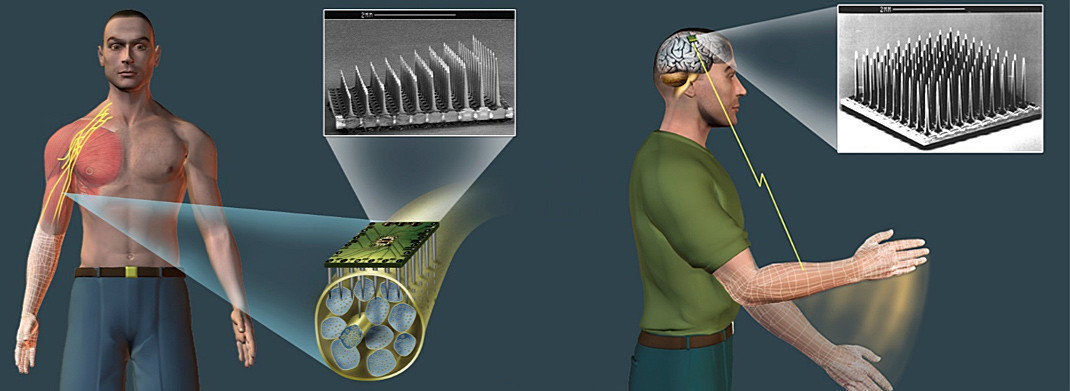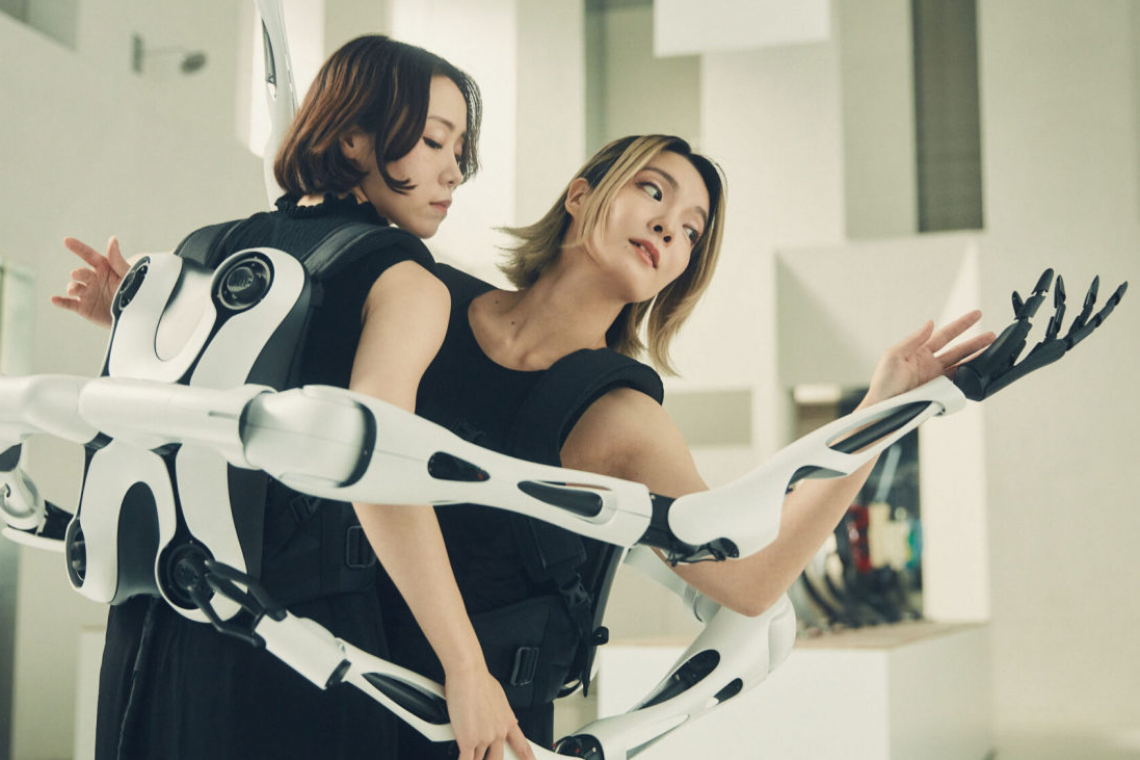Everyone is talking about smart electronics. The many buzzwords of the new smart little helpers - smart world, smart health, smart grid and smart robotics - are able to describe the future of electronics in a nutshell.
In the first 'PlattenTektonik' of the new year, I would like to focus on wearable electronics. 'Portable' in the sense of weight, i.e. electronics that are light and therefore easy to carry. 'Wearable' also in the sense of ethics, art and of course fashion as well as functionality - also known in common parlance as 'wearable electronics'.
Social Digital Cyborgs(Jizai Body Project) [1], [2]
"Half a century since the concept of a cyborg was introduced, JIZAI-Bodies (digital cyborgs), enabled by the spread of wearable robotics, are the focus of much research in recent times. JIZAI ARMS is a supernumerary robotic limb system consisting of a wearable base unit with six terminals and detachable robot arms. The system was designed to enable social interaction between multiple wearers, such as an exchange of arm(s), and explore possible interactions between digital cyborgs in a cyborg society."
 Fig. 1: Jizai Body Project - University of Tokyo (https://jizai-arms.com/)
Fig. 1: Jizai Body Project - University of Tokyo (https://jizai-arms.com/)
Once again, art knows how to present the whole thing in a fascinating way. Sometimes I miss that in the electronics environment. Cooperation between interdisciplinary teams would certainly be helpful here. Art colleges are often grateful to be able to present technical topics in a new light. You don't need a budget of millions for that. You just have to involve the students at the universities in the right way. Dear technicians: Open yourself up to such 'experiments'. This broadens the horizon and the possibilities of perception by those outside the field.
Basic building blocks: smart electronics and smart materials
'Wearable electronics' stands and falls with the use of smart materials, smart design concepts and not with the use of smart data and AI. Smart electronics such as wearable electronics require a smart environment - smart ideas as mentioned above ... a smart world. This 'smart world' can create a pleasant environment and a pleasant feeling for the user.
Ambient design is also part of this. Smart clothing adapts to the play of light in the environment, or the environment adapts to the user and their mood. Smart sensors have checked everything beforehand and coordinated it with the A. I. ... Pure feel-good atmosphere.
It can work like this, but it doesn't have to. You have to allow it and perhaps forget that something is 'working' on or in your body that doesn't really belong there.
We struggle with some things. Am I being monitored? What happens to 'my' data?
I don't want to go into the misuse of collected data / data phishing etc. or the topic of surveillance (where does surveillance begin and where does it end?) explicitly at this point.
We have long since accepted it as a matter of course for other things - such as hearing aids. Data exchange has also long been accepted and even life-saving for pacemakers and defibrillators, and software also works with intelligent orthoses/prostheses.
Dear technicians: Open up to such 'experiments'!
However, from a health point of view, understanding, acceptance and therefore use are weighted differently than in the work process or in the leisure sector (fitness trackers, entire fitness suites). Not only for reasons of data protection and stigmatization. In the case of hearing aids, the issue of stigmatization has now almost completely disappeared. Many people nowadays wear one or two 'earplugs' anyway. Implanted chips for data storage and access control are also commonplace for animals and 'cool' people. The situation is different in working life: the acceptance of certain little helpers, such as wearable power-assisted systems, is viewed very skeptically in the working environment for ethical reasons. They are therefore a long time coming. The situation is different in art, such as the aforementioned 'Jizai Body Project'. There, what otherwise seems impossible is possible.
 Fig. 2: Neuralink: If something is technically possible, it will be doneSome peoplewill be familiar with the slogan 'self-determined life'. But here, too, opinions differ. How far should wearable electronics and, above all, the software used with them (or should we say artificial intelligence) interfere with a self-determined life?
Fig. 2: Neuralink: If something is technically possible, it will be doneSome peoplewill be familiar with the slogan 'self-determined life'. But here, too, opinions differ. How far should wearable electronics and, above all, the software used with them (or should we say artificial intelligence) interfere with a self-determined life?
There are plenty of thoughts on this. Hollywood sends its regards when you think of films like 'RoboCop'. The fact that reality is not so far removed from this is also shown by a number of projects and developments that are thought-provoking or should be thought-provoking. 'Smart implants' is a huge topic.
Wearable electronics and smart robotics are key components
'Neuralink' makes you stop. Various activities surrounding this project have already been launched by tech billionaire Elon Musk. Naturally a popular topic for the media.
Wearables and A.I. interacting with the brain or even in the brain? Is that a good thing or not ....?
One thing is certain: if something is technically possible, it will be done.
Sometimes it takes a little longer for such ideas to become established. This is not least due to the enormous financial outlay involved. The topic is actually quite new. Back in the 1990s and 2000s, there were various projects to implement integrated electronics (especially chips as shown in Fig. 3-4) in the brain. Here too, various medical, ethical and not just technical aspects were addressed. [3] [4]
The supporting effect and the interaction with exoskeletons and wearables, such as sensors and actuators, thus open up considerable potential and the recovery of humanoid abilities.
 Fig. 3 and 4: Conceptual integration of wirelessly connected neurointerfaces in the brain (right) and periphery (left)
Fig. 3 and 4: Conceptual integration of wirelessly connected neurointerfaces in the brain (right) and periphery (left)
K. I./A. I. has been praised as a savior in the economy and is now reaching a completely different dimension through its use in social media, culture and politics - with unforeseen consequences. ChatGPT and ChaosGPT are the best-known examples.
In my view, the application of smart wearable electronics and the SmartWorld is inextricably linked to A. I. and only in this combination is it a future field of electronics and microelectronics.
Despite all the hype about A. I./A. I., however, important factors are being forgotten. Everyone is talking about it, and especially those who don't understand too much about it are praising this technology: digitalization is supposed to fix it. However, the German government and some business leaders have simply sat this issue out for the last 20 years or have only half-heartedly supported it. How can it be that a company that relies heavily on intelligent software is suddenly building better cars or creating pioneering products in the medical and robotics sectors (humanoid robots)?
Of course you need vision, but you also need staying power. It's not enough to get laws, regulations and other paper tigers off the ground and give armies of bureaucrats and 'influencers' a paid reason to exist for four to five years.
It is also not enough to use a tablet or a smartphone. Which, by the way, have long since not been adorned with a 'Made in Germany' label. When it comes to implementation, the development of portable and smart electronics and learning (keyword 'PISA study' sends its regards), technical understanding is needed above all - i.e. engineering knowledge! A general understanding of causalities from the fields of mathematics, physics and chemistry are important foundations. Otherwise, we will once again leave innovation to others, with whom we may find it difficult to compete, and not just in the daily economic race.
You can also look at it this way - in a smart world.
Best regards
Jan Kostelnik
www.tebko.de
Sources
[1] Jizai Body Project - University of Tokyo, https://jizai-arms.com/ and https://youtu.be/ywrK1yTYRIA (Retrieved: 20.12.2023).
[2] The many faces of wearables. Nat Electron 5, 709 (2022). https://doi.org/10.1038/s41928-022-00892-x (Retrieved: 20.12.2023).
[3] Kim, S., Bhandari, R., Klein, M., Negi, S., Rieth, L., Tathireddy, P., ... & Solzbacher, F. (2009). Integrated wireless neural interface based on the Utah electrode array. Biomedical microdevices, 11, 453-466.
[4] Sharma, A., Rieth, L., Tathireddy, P., Harrison, R., Oppermann, H., Klein, M., ... & Solzbacher, F. (2012). Evaluation of the packaging and encapsulation reliability in fully integrated, fully wireless 100 channel Utah Slant Electrode Array (USEA): Implications for long term functionality. Sensors and Actuators A: Physical, 188, 167-172.


